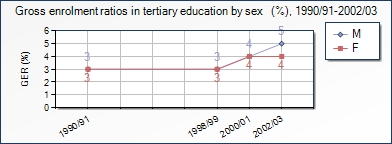Pocket statistics: Tertiary Education in Botswana
From WikiEducator
Contents
Overview of the tertiary education system in Botswana
The country has a population of approximately 1,770 000 people with 50% reported to reside in rural areas and 40% of the population between 0 and 14 years of age. Over the last decade, participation rates for tertiary education have increased by 67%.
Tertiary Gross Enrolment Ratio Statistics
| 1990/91 | 1998/99 | 2000/01 | 2002/03 | VUSSC Average | |
| MF Total | 3% | 3% | 4% | 5% | - |
| Male | 3% | 3% | 4% | 5% | - |
| Female | 3% | 3% | 4% | 4% | - |
There are XX government funded tertiary education institutions in the country providing learning opportunities for XX students. A strategic priority for Botswana's tertiary system is ...... Say something about ICT infrastructure and opportunities and challenges for elearning.
Government funded Tertiary Education Institutions
Name of institution (City)
| Name of Institution | University of Botswana |
| Website | http://www.ub.bw/ |
| Type of Institution | University |
| Main mode of delivery | Eg. Campus-based, Single mode DE, Mixed Mode etc. |
| Number of students | State number of students and year here, eg 13 547 (2004 fugures) |
| Learning Management System(s) | WebCT |
| Overview of e-learning | Enter brief description of e-learning activities at the institution |
Botswana College of Distance and Open Education, (Gaborone)
| Name of Institution | Botswana College of Distance and Open Education | |
| Website | www.moe.gov.bw./bocodol | |
| Type of Institution | College | |
| Main mode of delivery | Campus-based, dual mode, single mode DE | |
| Number of students | 6292 (2005) | |
| Learning Management System(s) | Construct Learner Management System supplied by Learning Advantage is South Africa. Also use Construct Author to convert material from word format to electronic content and us Construct Navigator to insert hyperlinks | |
| Overview of e-learning | With the college itself, e-Learning developments include purchasing of Learner Management System and training of Program Development Coordinators on converting existing course material to online content. The next phase of the project is to pilot e-Learning with some courses. | |
| If possible - the aggregate income composition of tertiary institutions between: Government grant, tuition fees, research and consulting income expressed as a percentage of total income | Governement subvention: 87%; tuition fees: 8%; other income: 5% |


